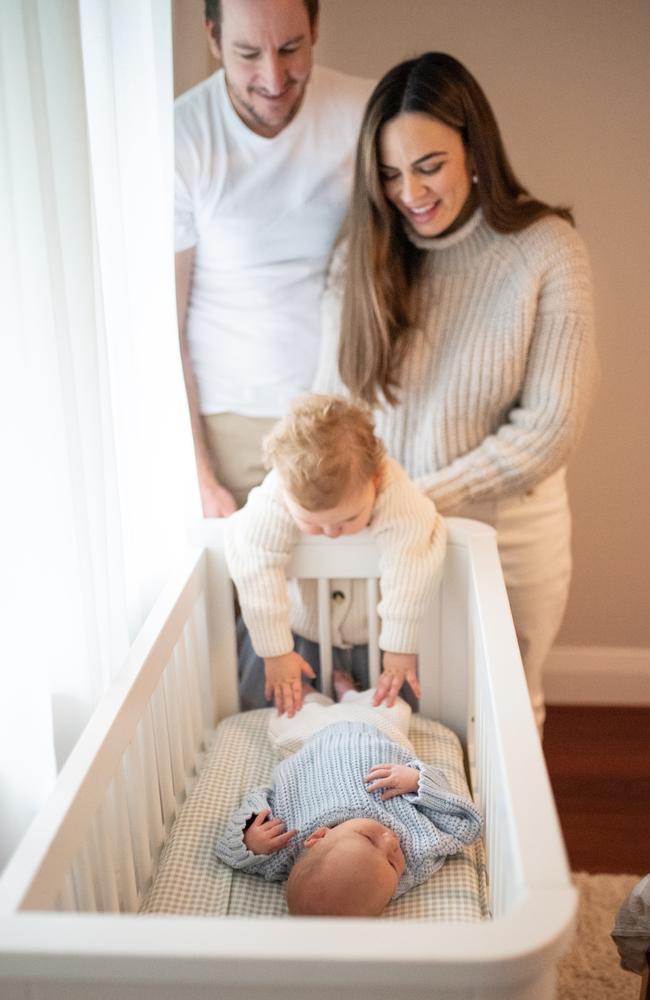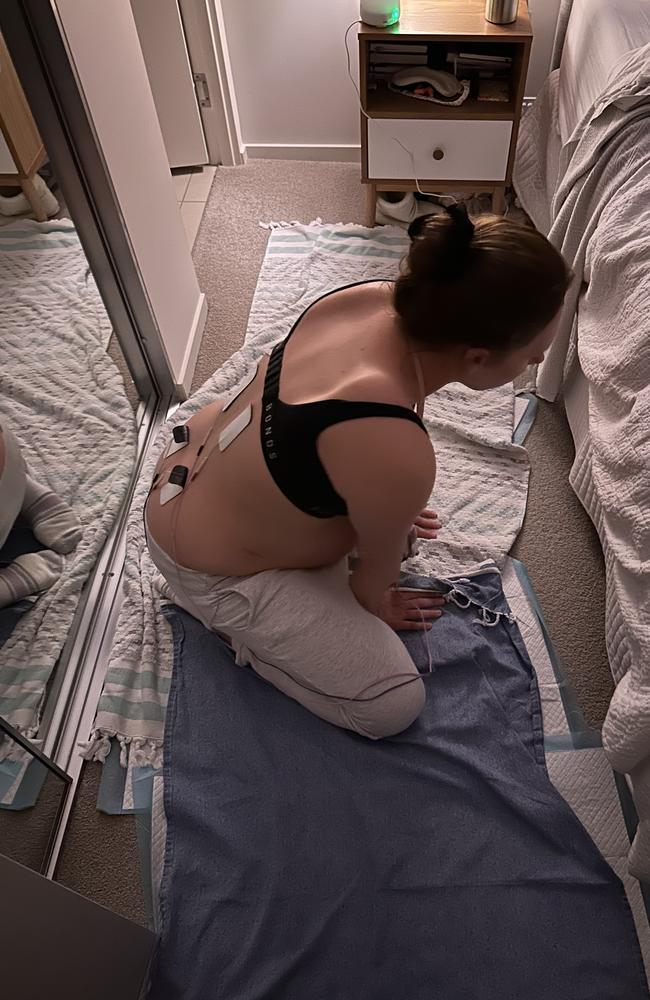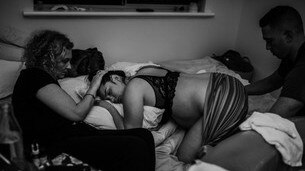‘Hospital is where sick people go’: Why an increasing number of Aussie women are choosing homebirths
I won’t romanticise it, it was tough. And just when I thought I couldn’t possibly deal anymore, seven words changed everything.

QWeekend
Don't miss out on the headlines from QWeekend. Followed categories will be added to My News.
‘Your baby is big – significantly big,” the obstetrician told me eight weeks before my due date. “Let’s book a caesarean.”
I’d been planning a drug-free water birth at a birth centre.
Instead, my care was transferred to hospital, where I had to undergo fortnightly growth scans and faced continuous pressure to induce or have surgery.
I was heartbroken, but still believed in myself and my body.
At every appointment I refused to book a C-section and then, at 40 weeks, I went into spontaneous labour.
I had no issues birthing a 4.23kg baby.
My little girl, Sunny, arrived in March 2021 at King Edward Memorial Hospital in Perth.
I felt strong. Empowered. And so proud of my body, despite what I felt turned into an unnecessarily medicalised birth.

Still, that obstetrician’s words never left me.
It mentally took a toll on me, having my baby labelled as big, and being told my body couldn’t do what it was naturally designed to do.
I never thought I’d be “that” person, but when planning my second child I started looking into home birth.
But only hippies have home births, right?
Well, the evidence was mind blowing.
I’ve been a journalist for 15 years. My partner is an engineer. We devoured the research. It was all overwhelmingly positive and pointed to it being a better option for me than birthing in a hospital.
So, when I fell pregnant last year, I started planning my home birth.
Melanie Jackson is a private practice midwife based in NSW who runs a mentoring program training other midwives in home birth.
She argues women are being let down by Australia’s over-medicalised maternity system.
“It’s absolutely safe for low-risk women to be having their babies at home with the care of a midwife,” she says.
“We know it’s safe because research has told us time and time again that it’s safe, and the only people who tell us it’s not are the people invested in perpetuating a medical approach to pregnancy.”
A June federal government report on mothers and babies shows almost 312,000 women
gave birth in Australia in 2021. Just 0.5 per cent, or 1560 babies, were born at home. It’s a small number but it’s almost double that of the year before, when 0.3 per cent of women birthed at home.
And Jackson believes even more babies would be born outside the hospital system if midwives could keep up with the demand.
“The only downside I can think of is there aren’t enough midwives,” Jackson says. “I turned away 170 women last year because I was fully booked.”
Australia has 15 publicly funded homebirth programs, in all states and territories except Queensland and Tasmania. In July, the Victorian government announced plans to expand its homebirth program at the Royal Women’s Hospital. If not accessing a public program, women can pay for the services of one of only 234 private practice midwives who attend home births across Australia.

Government statistics show that in our hospital system in 2021, 38 per cent of women give birth via caesarean – and one Perth hospital has a C-section rate of 54.5 per cent – and 34 per cent by induction. The system is statistically stacked against women who want a “normal” physiological labour and birth.
First-time mum Esther Twight-Eggins, 31, from Western Australia, was initially under the care of a private obstetrician but switched to a publicly-funded home birth model part way through her pregnancy. She gave birth to daughter Maia in the family’s living room in October last year.

“I’d seen my private obstetrician a number of times but it was just a 10-minute conversation,” she says. “But my midwife spent an hour and a half with me each time. It was just an incredibly different level of care.”
Peta Chien, 30 from Victoria, is another first-time mum who never entertained the idea of going to hospital to deliver her baby. Son Avi was born at home in March 2021.
“I felt like hospital is where sick people go and birth is not for sick people,’’ she says.
“I had an uncomplicated pregnancy, I was low risk. Birth felt like such a straightforward thing to me so I felt safest at home.”
Dr Clare Davison, a midwifery lecturer at Edith Cowan University, has conducted research into why women choose home birth and says one of the main reasons is birth trauma.
“The question isn’t why are women staying at home, but why are women not wanting to go to hospital?’’ she says.
“One in three women have birth trauma – not physical birth trauma, but actual psychological trauma. And this has been normalised in our society.’’

WA mum Kelly Sayers, 34, was “absolutely traumatised” by the birth of son Archie in 2021. She says doctors became concerned she was labouring for too long and her birth soon turned into a forceps-assisted delivery.
“I was just horrified by what had happened; it was just horrible,’’ she says.
Sayers and her partner had flashbacks to the birth for months, until they had a healing home birth for their second child, with daughter Everley born five months ago.
“Just knowing I was in my safe place at home made it so magical,” Sayers says. “When she was born I pulled her up and it was euphoric.”
The lowest incidence of birth trauma is among women who home birth with a
private midwife.
Those women also have higher breastfeeding rates, lower rates of post-partum depression and anxiety, as well as the physical benefits of no or minimal intervention.
An independent Cochrane review of planned home birth versus hospital birth found complications are more likely to arise in hospital, where birth is sped up through interventions such as inductions and artificially rupturing membranes, or when pain relief
is used.
The Royal Australian and New Zealand College of Obstetricians and Gynaecologists (RANZCOG) acknowledges “the outcomes for planned home birth are either similar to, or significantly higher than those reported hospital births for low-risk pregnancies”.
A RANZCOG spokesperson says, “Where it is appropriate and safe, having the choice of a planned home birth program provides women with shared decision making, which is an important factor in pregnancy care.”
But home birth isn’t for everyone, and in some cases hospital is the safest place, under the care of an obstetrician. There are restrictions in place under the Australian Health Practitioner Regulation Agency that don’t allow women with high-risk pregnancies – such as carrying twins or a breech baby – to give birth at home.
“Women aren’t broken,” Davison argues.
“Women are really good at getting pregnant, growing babies, birthing babies and breastfeeding, but they’re being let down by a system that doesn’t support it.’’
When I met my private midwife for the birth of my second child, she told me “your body won’t make a baby it can’t birth”. I instantly felt at ease. She believed in me.
Every appointment had such a high level of care, with the warmth of catching up with a friend. When my labour started it felt natural for her to be there, in my home. It was calming. I felt safe.
I won’t romanticise it, though: it was tough. The toughest thing I’ve ever done. And just when I thought I couldn’t possibly deal with one more contraction my midwife said “your baby is about to be born”.
Surrounded by fairy lights and a birth playlist I’d spent weeks curating, but didn’t notice, I hopped in the birth pool. The sweet relief of that warm water was exactly what I needed.
“I did it,” I said as I pulled my son on to my chest and absorbed his little frown, his folded-up froglike legs. I remember every wrinkle. How his body was so clean. There was no blood, hardly any vernix (white biofilm) on him.
And then it happened: that moment everyone talks about, the one we see in the movies where you meet your baby and the world makes sense. There are some things in life you can’t understand until you experience them. No word exists to describe that moment when I fell in love with my baby.
My midwife did all the necessary checks while Jagger stayed snuggled up on my chest. Then she cleaned up my birth space, and tucked us into our bed, where we started life as a family of four.




